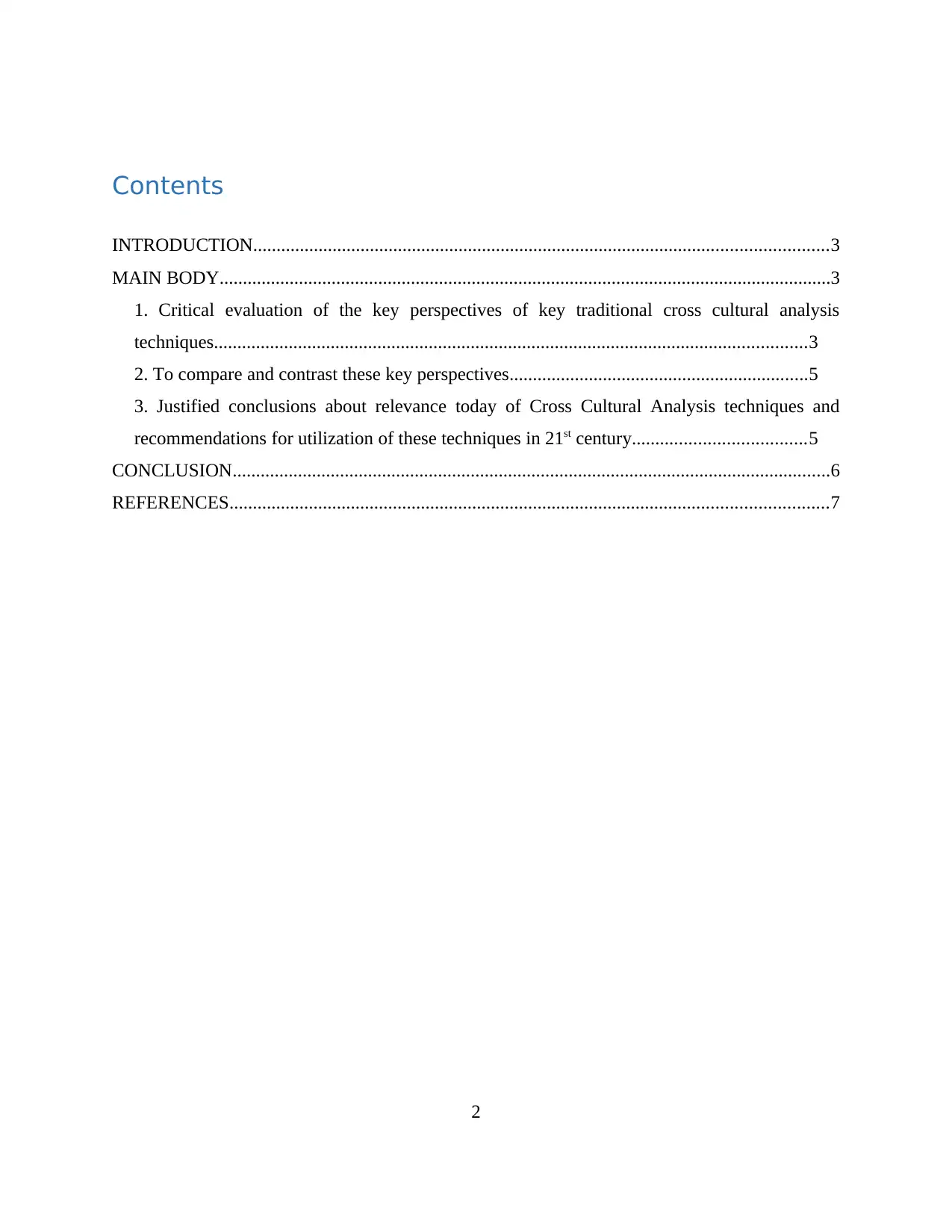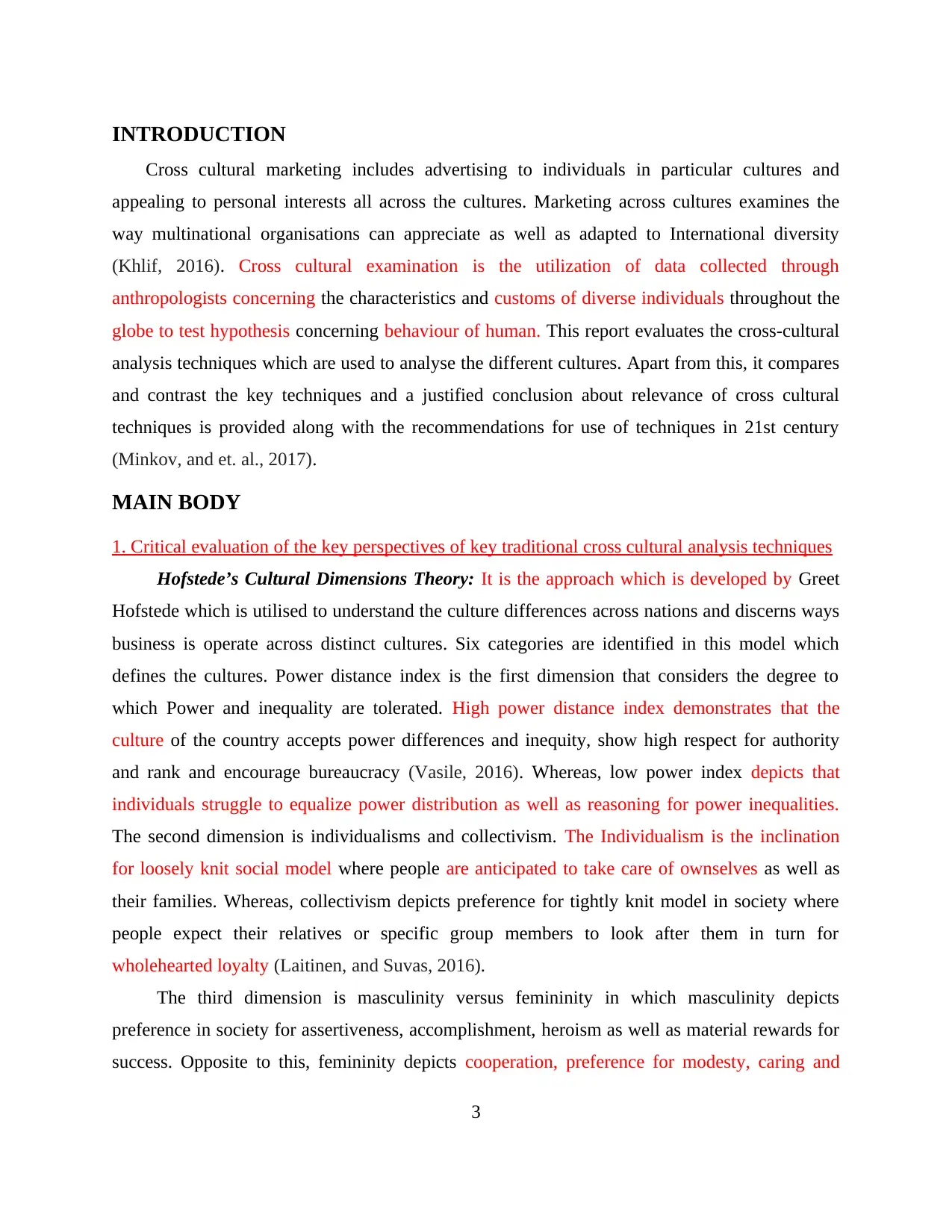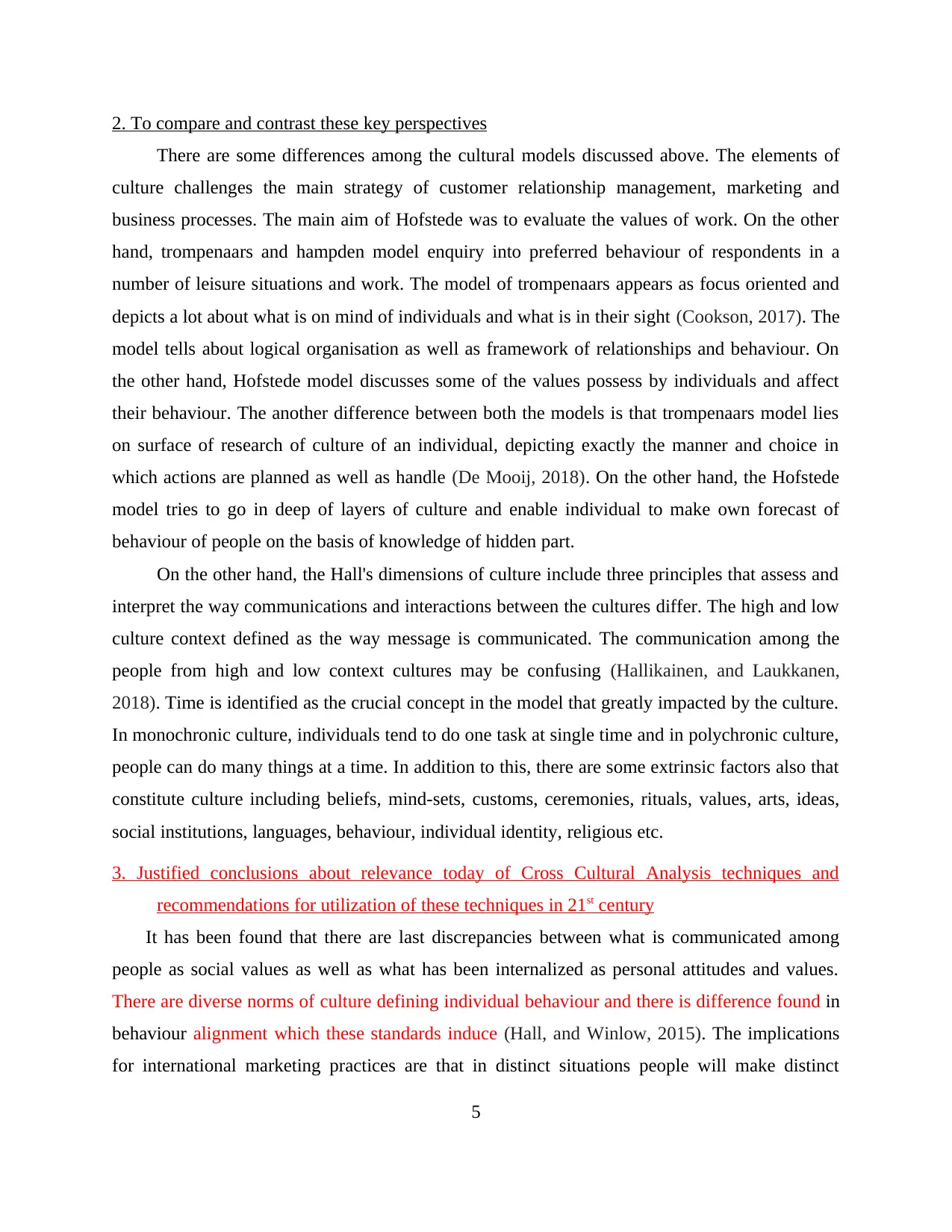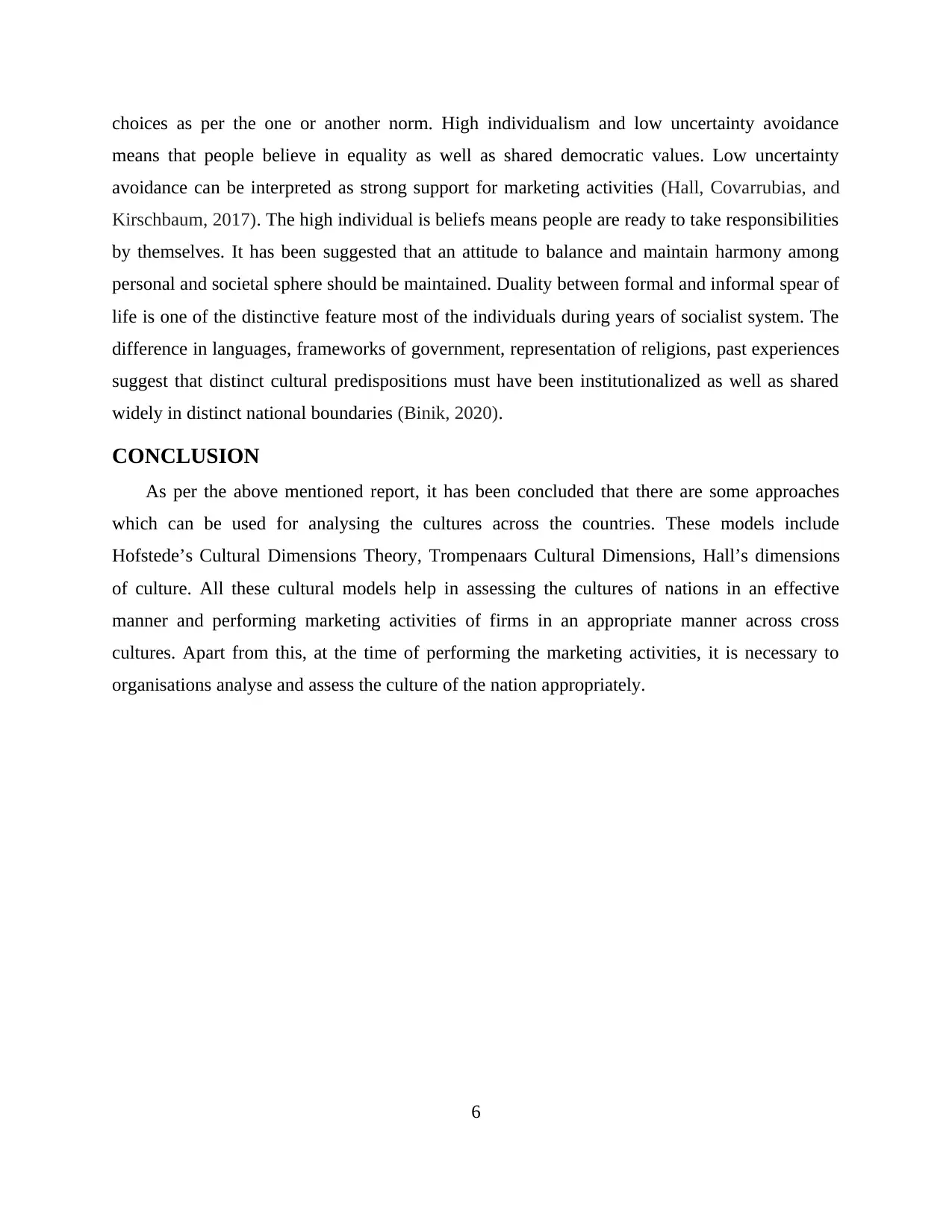Marketing across Cultures
VerifiedAdded on 2023/01/05
|7
|2069
|30
AI Summary
Please follow the assignment brief carefuly
Contribute Materials
Your contribution can guide someone’s learning journey. Share your
documents today.

Marketing across Cultures
1
1
Secure Best Marks with AI Grader
Need help grading? Try our AI Grader for instant feedback on your assignments.

Contents
INTRODUCTION...........................................................................................................................3
MAIN BODY...................................................................................................................................3
1. Critical evaluation of the key perspectives of key traditional cross cultural analysis
techniques...............................................................................................................................3
2. To compare and contrast these key perspectives................................................................5
3. Justified conclusions about relevance today of Cross Cultural Analysis techniques and
recommendations for utilization of these techniques in 21st century.....................................5
CONCLUSION................................................................................................................................6
REFERENCES................................................................................................................................7
2
INTRODUCTION...........................................................................................................................3
MAIN BODY...................................................................................................................................3
1. Critical evaluation of the key perspectives of key traditional cross cultural analysis
techniques...............................................................................................................................3
2. To compare and contrast these key perspectives................................................................5
3. Justified conclusions about relevance today of Cross Cultural Analysis techniques and
recommendations for utilization of these techniques in 21st century.....................................5
CONCLUSION................................................................................................................................6
REFERENCES................................................................................................................................7
2

INTRODUCTION
Cross cultural marketing includes advertising to individuals in particular cultures and
appealing to personal interests all across the cultures. Marketing across cultures examines the
way multinational organisations can appreciate as well as adapted to International diversity
(Khlif, 2016). Cross cultural examination is the utilization of data collected through
anthropologists concerning the characteristics and customs of diverse individuals throughout the
globe to test hypothesis concerning behaviour of human. This report evaluates the cross-cultural
analysis techniques which are used to analyse the different cultures. Apart from this, it compares
and contrast the key techniques and a justified conclusion about relevance of cross cultural
techniques is provided along with the recommendations for use of techniques in 21st century
(Minkov, and et. al., 2017).
MAIN BODY
1. Critical evaluation of the key perspectives of key traditional cross cultural analysis techniques
Hofstede’s Cultural Dimensions Theory: It is the approach which is developed by Greet
Hofstede which is utilised to understand the culture differences across nations and discerns ways
business is operate across distinct cultures. Six categories are identified in this model which
defines the cultures. Power distance index is the first dimension that considers the degree to
which Power and inequality are tolerated. High power distance index demonstrates that the
culture of the country accepts power differences and inequity, show high respect for authority
and rank and encourage bureaucracy (Vasile, 2016). Whereas, low power index depicts that
individuals struggle to equalize power distribution as well as reasoning for power inequalities.
The second dimension is individualisms and collectivism. The Individualism is the inclination
for loosely knit social model where people are anticipated to take care of ownselves as well as
their families. Whereas, collectivism depicts preference for tightly knit model in society where
people expect their relatives or specific group members to look after them in turn for
wholehearted loyalty (Laitinen, and Suvas, 2016).
The third dimension is masculinity versus femininity in which masculinity depicts
preference in society for assertiveness, accomplishment, heroism as well as material rewards for
success. Opposite to this, femininity depicts cooperation, preference for modesty, caring and
3
Cross cultural marketing includes advertising to individuals in particular cultures and
appealing to personal interests all across the cultures. Marketing across cultures examines the
way multinational organisations can appreciate as well as adapted to International diversity
(Khlif, 2016). Cross cultural examination is the utilization of data collected through
anthropologists concerning the characteristics and customs of diverse individuals throughout the
globe to test hypothesis concerning behaviour of human. This report evaluates the cross-cultural
analysis techniques which are used to analyse the different cultures. Apart from this, it compares
and contrast the key techniques and a justified conclusion about relevance of cross cultural
techniques is provided along with the recommendations for use of techniques in 21st century
(Minkov, and et. al., 2017).
MAIN BODY
1. Critical evaluation of the key perspectives of key traditional cross cultural analysis techniques
Hofstede’s Cultural Dimensions Theory: It is the approach which is developed by Greet
Hofstede which is utilised to understand the culture differences across nations and discerns ways
business is operate across distinct cultures. Six categories are identified in this model which
defines the cultures. Power distance index is the first dimension that considers the degree to
which Power and inequality are tolerated. High power distance index demonstrates that the
culture of the country accepts power differences and inequity, show high respect for authority
and rank and encourage bureaucracy (Vasile, 2016). Whereas, low power index depicts that
individuals struggle to equalize power distribution as well as reasoning for power inequalities.
The second dimension is individualisms and collectivism. The Individualism is the inclination
for loosely knit social model where people are anticipated to take care of ownselves as well as
their families. Whereas, collectivism depicts preference for tightly knit model in society where
people expect their relatives or specific group members to look after them in turn for
wholehearted loyalty (Laitinen, and Suvas, 2016).
The third dimension is masculinity versus femininity in which masculinity depicts
preference in society for assertiveness, accomplishment, heroism as well as material rewards for
success. Opposite to this, femininity depicts cooperation, preference for modesty, caring and
3

quality of life, for the weak. The fourth dimension is uncertainty avoidance index which states
the extent to which society members feels uncomfortable ambiguity and vagueness. The key
issue here is the way society deals with the circumstance that forthcoming time can never be
known. Short term normative orientation versus long term orientation is the fifth dimension
according to which each society device to uphold some links with past at the time of dealing with
present challenges and future challenges (Pîrlog, 2017). The society with low score dimension
prefers to maintain norms and time honoured traditions when viewing change with suspicion.
Besides this, high score culture take more practical method. Indulgence versus restraint is the last
dimension which means society that enable free gratification of natural and basic human drives
related to liking life and having fun. This model is very helpful in understanding the culture on
society and life of individuals (Smale, and et. al., 2019).
Trompenaars Cultural Dimensions: This is the model which can assist in working more
effectively with individuals from different cultures. Trompenaars and Hampden turner define
cultural dimensions’ extensive database. Its seven cultural dimensions includes Universalism
versus particularism, achievement versus escription, specific versus diffuse, neutral versus
affective, individualism versus communitarianism, sequential time versus synchronous time and
internal direction vs external direction. This model has no consistent and clear way to utilise it.
However, this model can be used through self-evaluate any kind of misunderstanding is caused
by cultural differences. This model can be used by scoring the individual against each direction
and by examining those dimensions with highest scores (Zakaria, and Yusof, 2015).
Hall’s dimensions of culture: This framework was given by Edward Twitchell hall who
was an American anthropologist. Four main cultural concepts were given by the author among
which the concept of contexting is well known. As per this concept, it is possible to organise the
cultures on a scale from high to low. This means that some cultures interact more implicit and
requires less background information. On the other hand, other cultures communicate explicitly
and requires more background information (Gómez-Rey, Barbera, and Fernández-Navarro,
2016). The another dimension is messaging which regards the flow or pace of communication.
The other two dimensional includes space and time.
4
the extent to which society members feels uncomfortable ambiguity and vagueness. The key
issue here is the way society deals with the circumstance that forthcoming time can never be
known. Short term normative orientation versus long term orientation is the fifth dimension
according to which each society device to uphold some links with past at the time of dealing with
present challenges and future challenges (Pîrlog, 2017). The society with low score dimension
prefers to maintain norms and time honoured traditions when viewing change with suspicion.
Besides this, high score culture take more practical method. Indulgence versus restraint is the last
dimension which means society that enable free gratification of natural and basic human drives
related to liking life and having fun. This model is very helpful in understanding the culture on
society and life of individuals (Smale, and et. al., 2019).
Trompenaars Cultural Dimensions: This is the model which can assist in working more
effectively with individuals from different cultures. Trompenaars and Hampden turner define
cultural dimensions’ extensive database. Its seven cultural dimensions includes Universalism
versus particularism, achievement versus escription, specific versus diffuse, neutral versus
affective, individualism versus communitarianism, sequential time versus synchronous time and
internal direction vs external direction. This model has no consistent and clear way to utilise it.
However, this model can be used through self-evaluate any kind of misunderstanding is caused
by cultural differences. This model can be used by scoring the individual against each direction
and by examining those dimensions with highest scores (Zakaria, and Yusof, 2015).
Hall’s dimensions of culture: This framework was given by Edward Twitchell hall who
was an American anthropologist. Four main cultural concepts were given by the author among
which the concept of contexting is well known. As per this concept, it is possible to organise the
cultures on a scale from high to low. This means that some cultures interact more implicit and
requires less background information. On the other hand, other cultures communicate explicitly
and requires more background information (Gómez-Rey, Barbera, and Fernández-Navarro,
2016). The another dimension is messaging which regards the flow or pace of communication.
The other two dimensional includes space and time.
4
Secure Best Marks with AI Grader
Need help grading? Try our AI Grader for instant feedback on your assignments.

2. To compare and contrast these key perspectives
There are some differences among the cultural models discussed above. The elements of
culture challenges the main strategy of customer relationship management, marketing and
business processes. The main aim of Hofstede was to evaluate the values of work. On the other
hand, trompenaars and hampden model enquiry into preferred behaviour of respondents in a
number of leisure situations and work. The model of trompenaars appears as focus oriented and
depicts a lot about what is on mind of individuals and what is in their sight (Cookson, 2017). The
model tells about logical organisation as well as framework of relationships and behaviour. On
the other hand, Hofstede model discusses some of the values possess by individuals and affect
their behaviour. The another difference between both the models is that trompenaars model lies
on surface of research of culture of an individual, depicting exactly the manner and choice in
which actions are planned as well as handle (De Mooij, 2018). On the other hand, the Hofstede
model tries to go in deep of layers of culture and enable individual to make own forecast of
behaviour of people on the basis of knowledge of hidden part.
On the other hand, the Hall's dimensions of culture include three principles that assess and
interpret the way communications and interactions between the cultures differ. The high and low
culture context defined as the way message is communicated. The communication among the
people from high and low context cultures may be confusing (Hallikainen, and Laukkanen,
2018). Time is identified as the crucial concept in the model that greatly impacted by the culture.
In monochronic culture, individuals tend to do one task at single time and in polychronic culture,
people can do many things at a time. In addition to this, there are some extrinsic factors also that
constitute culture including beliefs, mind-sets, customs, ceremonies, rituals, values, arts, ideas,
social institutions, languages, behaviour, individual identity, religious etc.
3. Justified conclusions about relevance today of Cross Cultural Analysis techniques and
recommendations for utilization of these techniques in 21st century
It has been found that there are last discrepancies between what is communicated among
people as social values as well as what has been internalized as personal attitudes and values.
There are diverse norms of culture defining individual behaviour and there is difference found in
behaviour alignment which these standards induce (Hall, and Winlow, 2015). The implications
for international marketing practices are that in distinct situations people will make distinct
5
There are some differences among the cultural models discussed above. The elements of
culture challenges the main strategy of customer relationship management, marketing and
business processes. The main aim of Hofstede was to evaluate the values of work. On the other
hand, trompenaars and hampden model enquiry into preferred behaviour of respondents in a
number of leisure situations and work. The model of trompenaars appears as focus oriented and
depicts a lot about what is on mind of individuals and what is in their sight (Cookson, 2017). The
model tells about logical organisation as well as framework of relationships and behaviour. On
the other hand, Hofstede model discusses some of the values possess by individuals and affect
their behaviour. The another difference between both the models is that trompenaars model lies
on surface of research of culture of an individual, depicting exactly the manner and choice in
which actions are planned as well as handle (De Mooij, 2018). On the other hand, the Hofstede
model tries to go in deep of layers of culture and enable individual to make own forecast of
behaviour of people on the basis of knowledge of hidden part.
On the other hand, the Hall's dimensions of culture include three principles that assess and
interpret the way communications and interactions between the cultures differ. The high and low
culture context defined as the way message is communicated. The communication among the
people from high and low context cultures may be confusing (Hallikainen, and Laukkanen,
2018). Time is identified as the crucial concept in the model that greatly impacted by the culture.
In monochronic culture, individuals tend to do one task at single time and in polychronic culture,
people can do many things at a time. In addition to this, there are some extrinsic factors also that
constitute culture including beliefs, mind-sets, customs, ceremonies, rituals, values, arts, ideas,
social institutions, languages, behaviour, individual identity, religious etc.
3. Justified conclusions about relevance today of Cross Cultural Analysis techniques and
recommendations for utilization of these techniques in 21st century
It has been found that there are last discrepancies between what is communicated among
people as social values as well as what has been internalized as personal attitudes and values.
There are diverse norms of culture defining individual behaviour and there is difference found in
behaviour alignment which these standards induce (Hall, and Winlow, 2015). The implications
for international marketing practices are that in distinct situations people will make distinct
5

choices as per the one or another norm. High individualism and low uncertainty avoidance
means that people believe in equality as well as shared democratic values. Low uncertainty
avoidance can be interpreted as strong support for marketing activities (Hall, Covarrubias, and
Kirschbaum, 2017). The high individual is beliefs means people are ready to take responsibilities
by themselves. It has been suggested that an attitude to balance and maintain harmony among
personal and societal sphere should be maintained. Duality between formal and informal spear of
life is one of the distinctive feature most of the individuals during years of socialist system. The
difference in languages, frameworks of government, representation of religions, past experiences
suggest that distinct cultural predispositions must have been institutionalized as well as shared
widely in distinct national boundaries (Binik, 2020).
CONCLUSION
As per the above mentioned report, it has been concluded that there are some approaches
which can be used for analysing the cultures across the countries. These models include
Hofstede’s Cultural Dimensions Theory, Trompenaars Cultural Dimensions, Hall’s dimensions
of culture. All these cultural models help in assessing the cultures of nations in an effective
manner and performing marketing activities of firms in an appropriate manner across cross
cultures. Apart from this, at the time of performing the marketing activities, it is necessary to
organisations analyse and assess the culture of the nation appropriately.
6
means that people believe in equality as well as shared democratic values. Low uncertainty
avoidance can be interpreted as strong support for marketing activities (Hall, Covarrubias, and
Kirschbaum, 2017). The high individual is beliefs means people are ready to take responsibilities
by themselves. It has been suggested that an attitude to balance and maintain harmony among
personal and societal sphere should be maintained. Duality between formal and informal spear of
life is one of the distinctive feature most of the individuals during years of socialist system. The
difference in languages, frameworks of government, representation of religions, past experiences
suggest that distinct cultural predispositions must have been institutionalized as well as shared
widely in distinct national boundaries (Binik, 2020).
CONCLUSION
As per the above mentioned report, it has been concluded that there are some approaches
which can be used for analysing the cultures across the countries. These models include
Hofstede’s Cultural Dimensions Theory, Trompenaars Cultural Dimensions, Hall’s dimensions
of culture. All these cultural models help in assessing the cultures of nations in an effective
manner and performing marketing activities of firms in an appropriate manner across cross
cultures. Apart from this, at the time of performing the marketing activities, it is necessary to
organisations analyse and assess the culture of the nation appropriately.
6

REFERENCES
Books and Journals
Khlif, H., 2016. Hofstede’s cultural dimensions in accounting research: a review. Meditari
Accountancy Research.
Vasile, A.C., 2016. Hofstede’s cultural dimensions and management in corporations. Cross-
Cultural Management Journal, 18(01), pp.35-46.
Minkov, M., and et. al., 2017. A revision of Hofstede’s individualism-collectivism
dimension. Cross Cultural & Strategic Management.
Laitinen, E.K. and Suvas, A., 2016. Financial distress prediction in an international context:
Moderating effects of Hofstede’s original cultural dimensions. Journal of Behavioral and
Experimental Finance, 9, pp.98-118.
Pîrlog, A., 2017. Analysis of the Dimensions of National Culture in the Republic of Moldova
According to Fons’ Trompenaars and Hampden-Turner’s Model. In Simpozionul ştiinţific
al tinerilor cercetători (pp. 161-165).
Zakaria, N. and Yusof, S.A.M., 2015. Can we count on you at a distance? The impact of culture
on formation of swift trust within global virtual teams. In Leading global teams (pp. 253-
268). Springer, New York, NY.
Gómez-Rey, P., Barbera, E. and Fernández-Navarro, F., 2016. The impact of cultural dimensions
on online learning. Educational Technology & Society, 19(4), pp.225-238.
Cookson, S., 2017. Culture in the cockpit: implications for CRM training. In Advances in Cross-
Cultural Decision Making(pp. 119-131). Springer, Cham.
Hallikainen, H. and Laukkanen, T., 2018. National culture and consumer trust in e-
commerce. International Journal of Information Management, 38(1), pp.97-106.
Smale, A., and et. al., 2019. Proactive career behaviors and subjective career success: The
moderating role of national culture. Journal of Organizational Behavior, 40(1), pp.105-
122.
Hall, S. and Winlow, S., 2015. Revitalizing Criminological Theory:: Towards a new Ultra-
Realism. Routledge.
Hall, B.J., Covarrubias, P.O. and Kirschbaum, K.A., 2017. Among cultures: The challenge of
communication. Routledge.
Binik, O., 2020. In the Cultural Criminology Hall of Mirrors. In The Fascination with Violence
in Contemporary Society (pp. 99-115). Palgrave Macmillan, Cham.
De Mooij, M., 2018. Global marketing and advertising: Understanding cultural paradoxes.
SAGE Publications Limited.
Online
https://core.ac.uk/download/pdf/192200686.pdf
7
Books and Journals
Khlif, H., 2016. Hofstede’s cultural dimensions in accounting research: a review. Meditari
Accountancy Research.
Vasile, A.C., 2016. Hofstede’s cultural dimensions and management in corporations. Cross-
Cultural Management Journal, 18(01), pp.35-46.
Minkov, M., and et. al., 2017. A revision of Hofstede’s individualism-collectivism
dimension. Cross Cultural & Strategic Management.
Laitinen, E.K. and Suvas, A., 2016. Financial distress prediction in an international context:
Moderating effects of Hofstede’s original cultural dimensions. Journal of Behavioral and
Experimental Finance, 9, pp.98-118.
Pîrlog, A., 2017. Analysis of the Dimensions of National Culture in the Republic of Moldova
According to Fons’ Trompenaars and Hampden-Turner’s Model. In Simpozionul ştiinţific
al tinerilor cercetători (pp. 161-165).
Zakaria, N. and Yusof, S.A.M., 2015. Can we count on you at a distance? The impact of culture
on formation of swift trust within global virtual teams. In Leading global teams (pp. 253-
268). Springer, New York, NY.
Gómez-Rey, P., Barbera, E. and Fernández-Navarro, F., 2016. The impact of cultural dimensions
on online learning. Educational Technology & Society, 19(4), pp.225-238.
Cookson, S., 2017. Culture in the cockpit: implications for CRM training. In Advances in Cross-
Cultural Decision Making(pp. 119-131). Springer, Cham.
Hallikainen, H. and Laukkanen, T., 2018. National culture and consumer trust in e-
commerce. International Journal of Information Management, 38(1), pp.97-106.
Smale, A., and et. al., 2019. Proactive career behaviors and subjective career success: The
moderating role of national culture. Journal of Organizational Behavior, 40(1), pp.105-
122.
Hall, S. and Winlow, S., 2015. Revitalizing Criminological Theory:: Towards a new Ultra-
Realism. Routledge.
Hall, B.J., Covarrubias, P.O. and Kirschbaum, K.A., 2017. Among cultures: The challenge of
communication. Routledge.
Binik, O., 2020. In the Cultural Criminology Hall of Mirrors. In The Fascination with Violence
in Contemporary Society (pp. 99-115). Palgrave Macmillan, Cham.
De Mooij, M., 2018. Global marketing and advertising: Understanding cultural paradoxes.
SAGE Publications Limited.
Online
https://core.ac.uk/download/pdf/192200686.pdf
7
1 out of 7
Related Documents
Your All-in-One AI-Powered Toolkit for Academic Success.
+13062052269
info@desklib.com
Available 24*7 on WhatsApp / Email
![[object Object]](/_next/static/media/star-bottom.7253800d.svg)
Unlock your academic potential
© 2024 | Zucol Services PVT LTD | All rights reserved.




